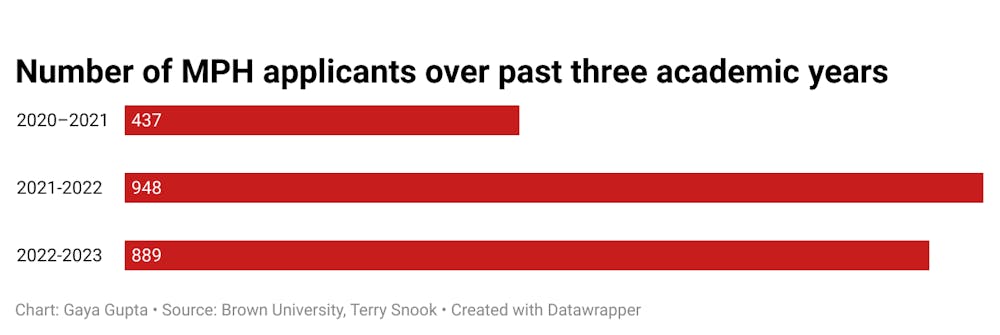In the two years since the onset of the pandemic, the number of applicants to Brown’s Master of Public Health programs have more than doubled.
The number of applicants rose from 437 in the 2020–2021 academic year to 948 applicants this 2021-2022 academic year and 889 for the 2022-2023 academic year, according to a March 10, 2021 press release and an email from Terry Snook, senior data analyst at the Graduate School.
Between the 2020-2021 and 2021-2022 academic years, the school saw an even larger increase of applications among students of color, with a 187% increase in students who identify as Black or African American and a 137% increase in applicants who identify as Latinx.
This increase exceeds national trends, which saw an increase in MPH applications of 20-30% in 2021, according to the Association of Schools and Programs of Public Health.
The number of students enrolled in the MPH program has been slowly expanding for the past several years, according to the Brown Office of Institutional Research. Between the fall of 2012 and fall of 2020, the number of students in the public health program increased from 70 students to 96 students. In response to the increase in applications, the MPH program increased their class size to 155 students in the 2021-2022 academic year, marking an increase of about 62%.
The School of Public Health does not anticipate increasing class size further for the 2022-2023 academic year, according to Megan Ranney MPH ’10, emergency physician and academic dean of Brown’s School of Public Health. “We want to maintain the quality of faculty-student interaction and get that trademark Brown way,” Ranney said. This means keeping class size manageable, she added.
Some of this past and continuous growth might be due to COVID-19 sparking a broader interest in public health, Ranney said.
During the pandemic, “the value of public health got demonstrated in real time,” she said. “Folks also saw where public health wasn’t able to do enough … and they want to be a part of the solution.”
Ranney believes that the new leadership and vision behind the School of Public Health are two additional factors attracting students to apply.
Students “know that they are going to learn how to help change the world and create a more equitable and forward-looking version of public health” at Brown, Ranney said.
According to the MPH Program Director Annie Gjelsvik PHD’03, enrollment in the subsidiary fifth-year MPH program has also increased. This program — which allows students to obtain an undergraduate degree and an MPH in five years, according to the program’s website — is only open to Brown undergraduates.
“I think the pandemic made a lot of people realize how important public health” is, including pre-med students who realized “public health could be really relevant for them in their careers,” Molly Siegel ’23, who is in the fifth-year MPH program, said.
Siegel believes that the School of Public Health has been “climbing the rankings” under Dean Ashish Jha’s leadership and growing recognition during the pandemic, leading to additional funding and global attention that has increased the competitiveness of the program.
Jha was named one of World’s 50 Greatest Leaders by Fortune Magazine in 2021 and is currently the White House COVID-19 response coordinator, the Herald previously reported.
In addition to its greater media attention, the School of Public Health has made some structural changes that have increased the number of enrolled MPH students.
The fifth-year program was previously only open to public health concentrators in the honors program, according to Gjelsvik. But in the past few years, the program has allowed applicants from all Brown students, regardless of concentration.
The School of Public Health also recently added a new, fully online MPH option, The Herald previously reported.
To facilitate growth in the program, the MPH program is hiring additional faculty, according to Gjelsvik.
“We added … three staff positions this past fall,” said Gjelsvik. Some of the core courses are now offering additional sections, both in the fall and spring, Gjelsvik added.
Overall, Gjelsvik said she is really excited to see the increased number of applicants and evidence of a broader interest in public health.
“We were worried about turnover and retirement (among the public health workforce) before the pandemic, and now we’re really worried about it,” said Gjelsvik. “We’re just so excited that we’re able to attract these students and get people interested in … this career because it really is necessary within the United States and globally.”





